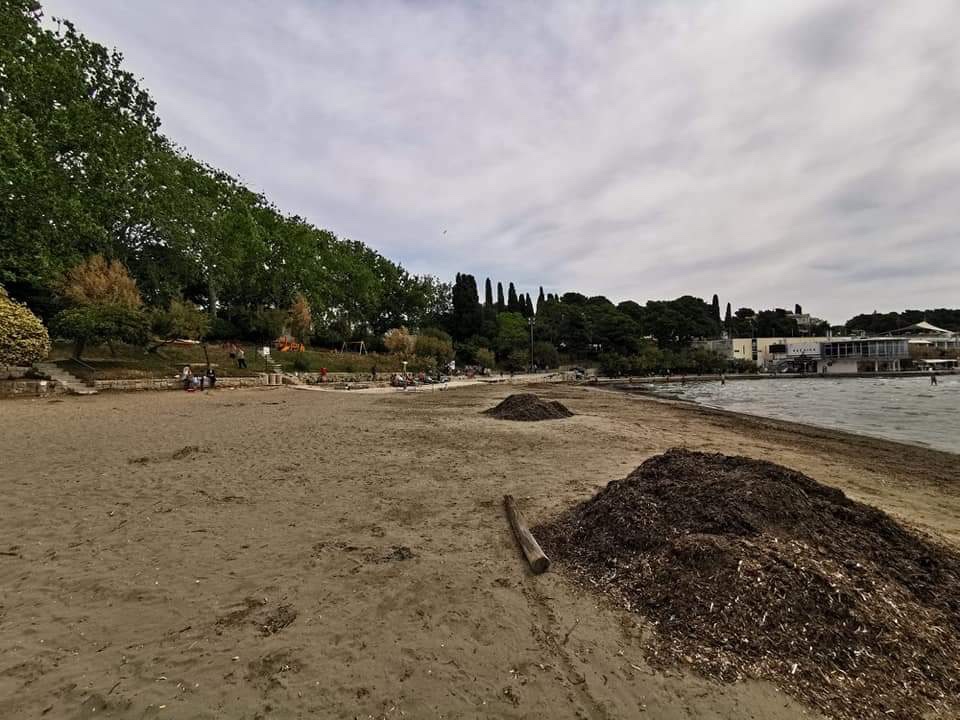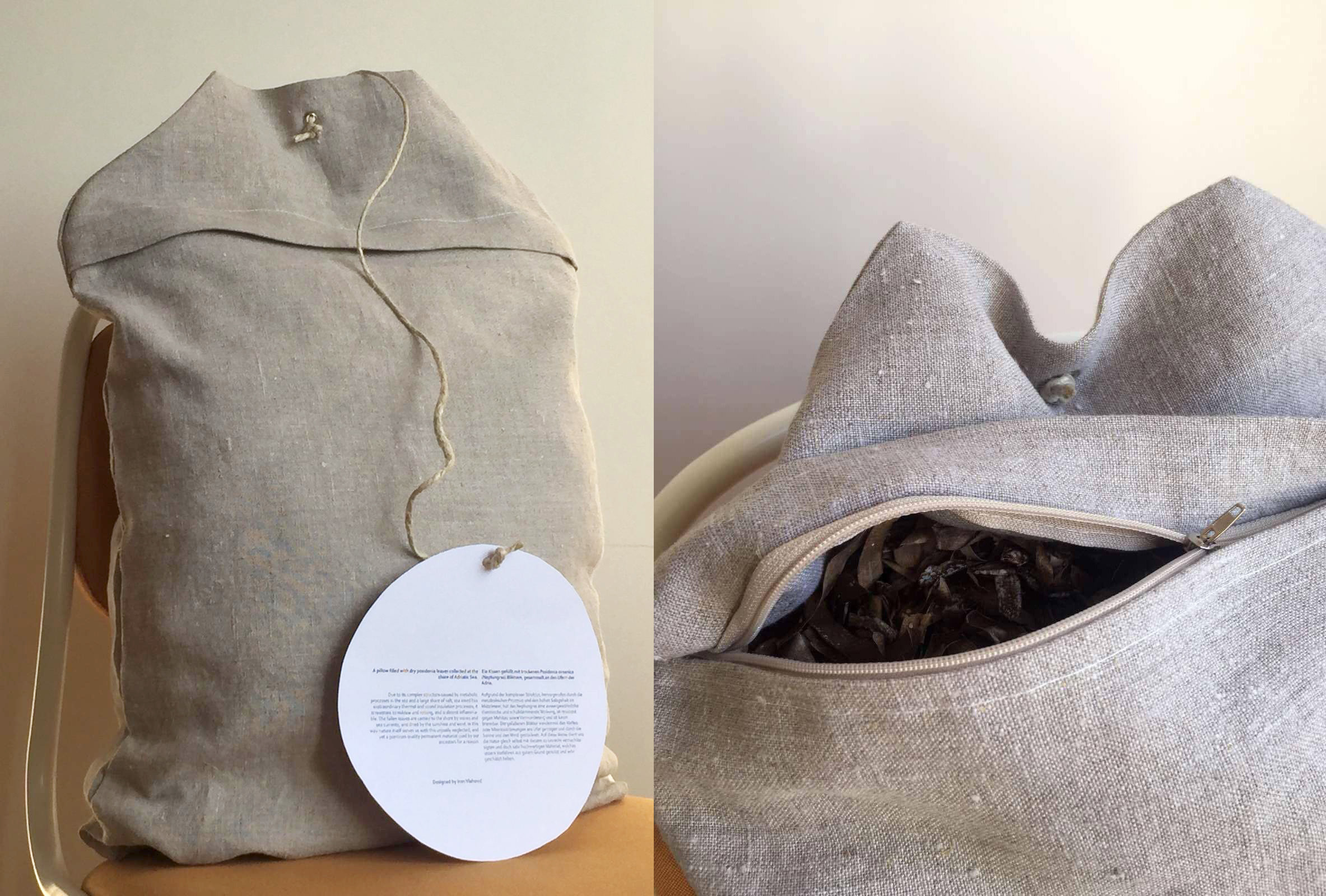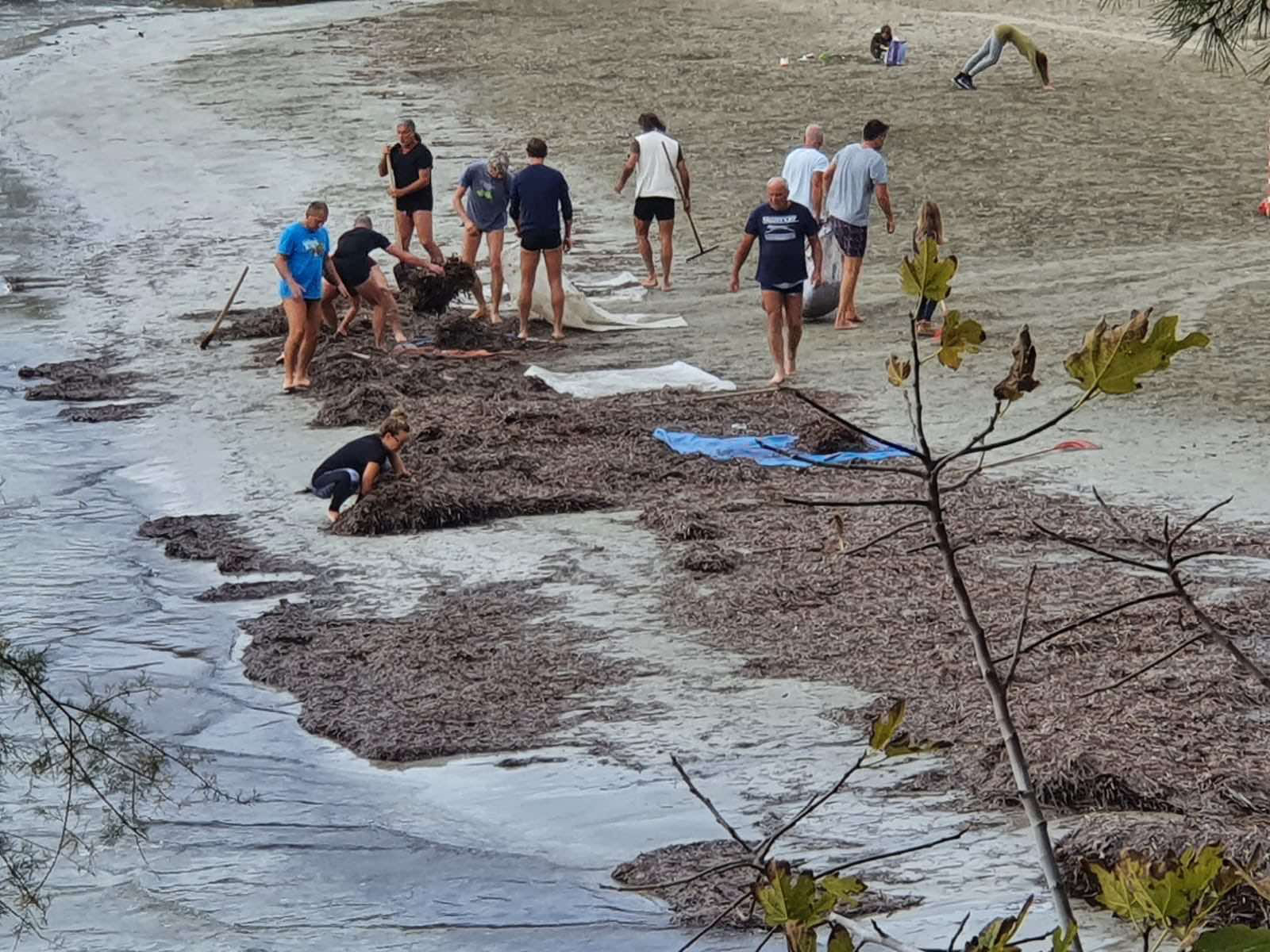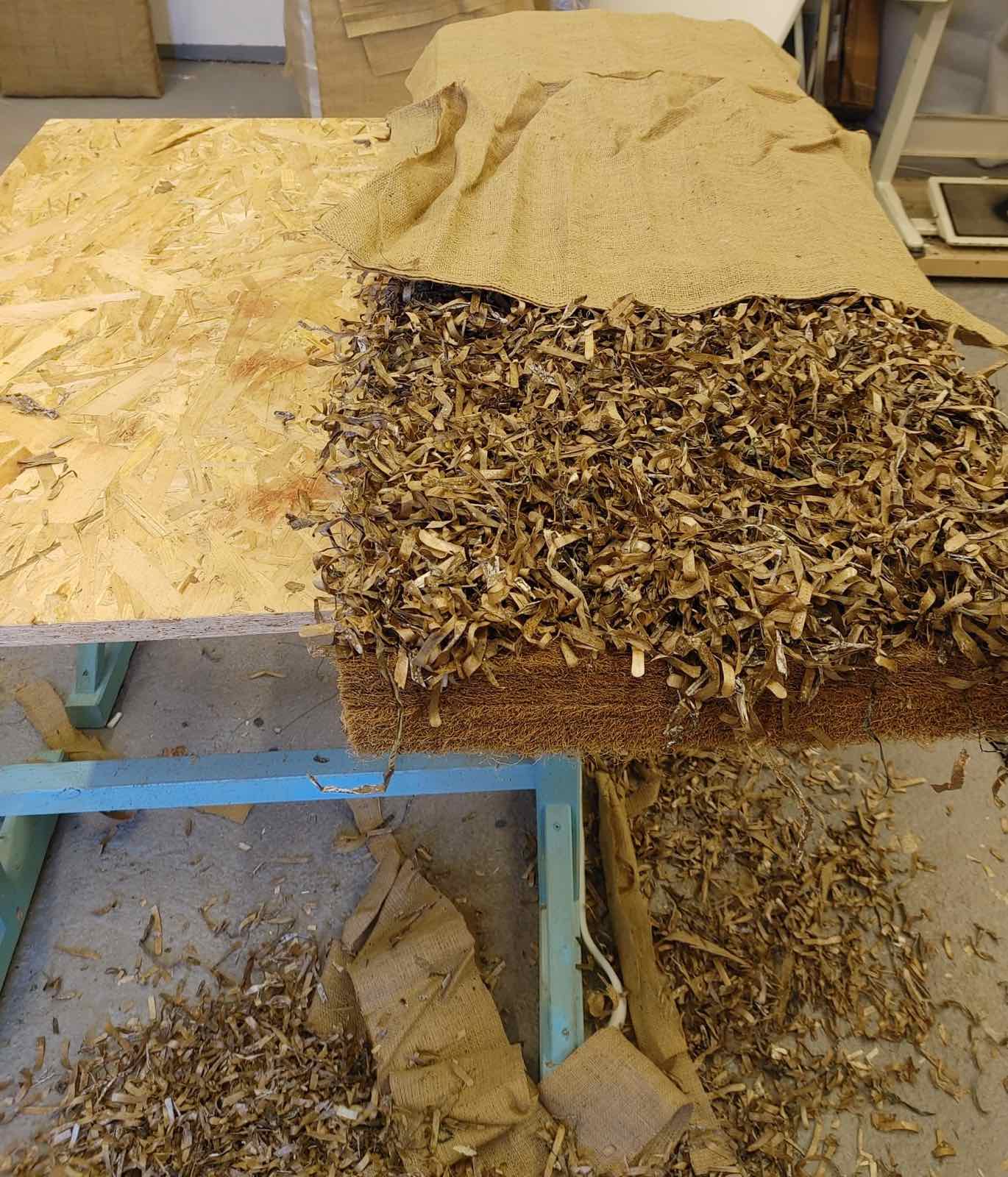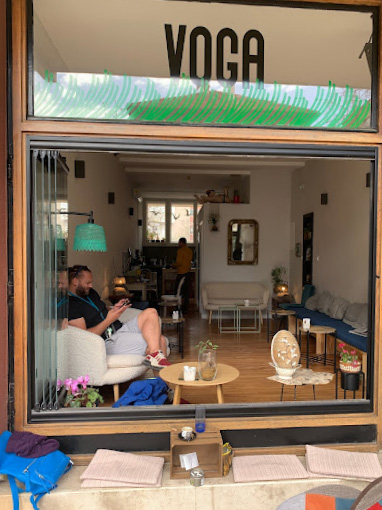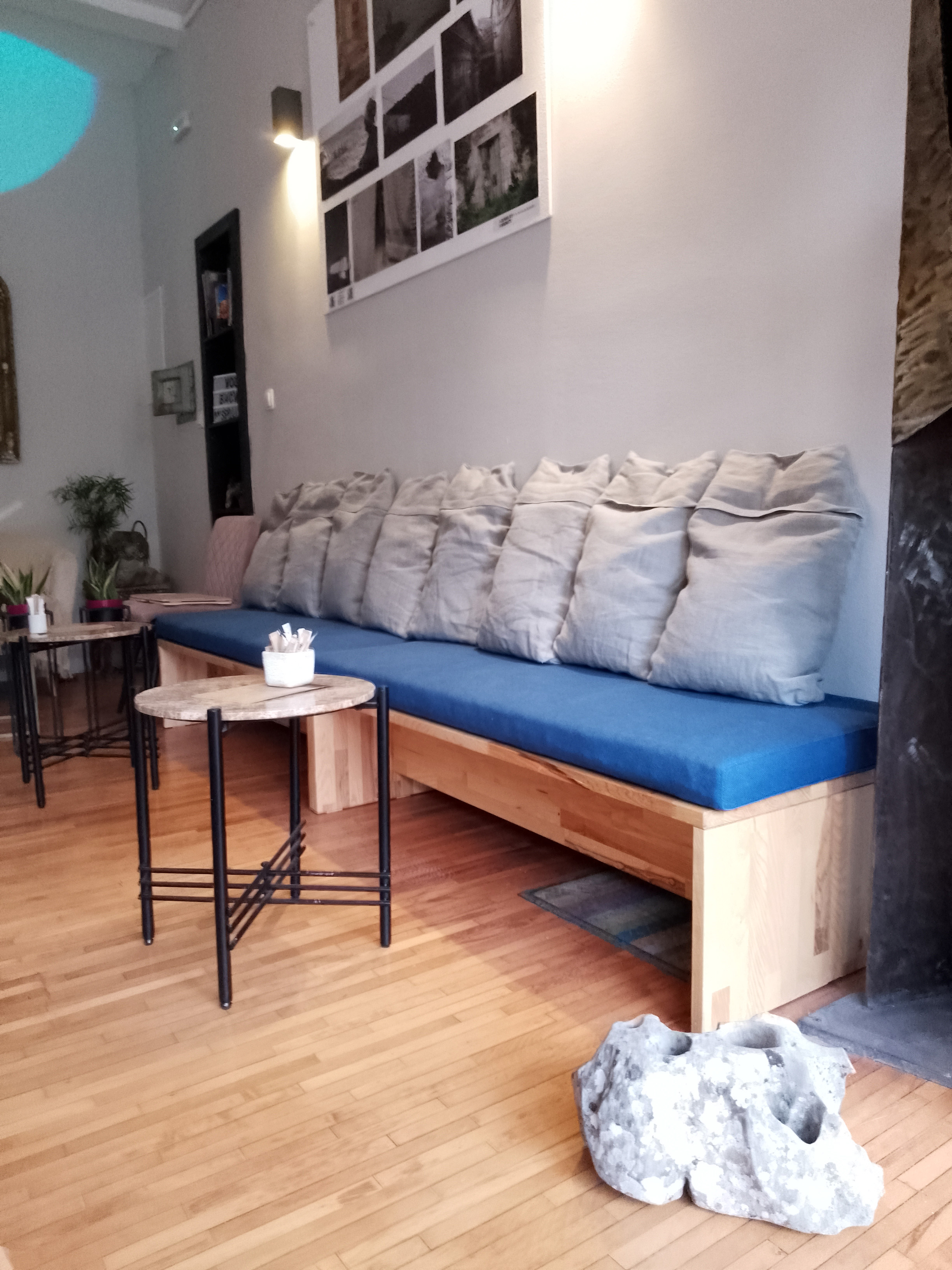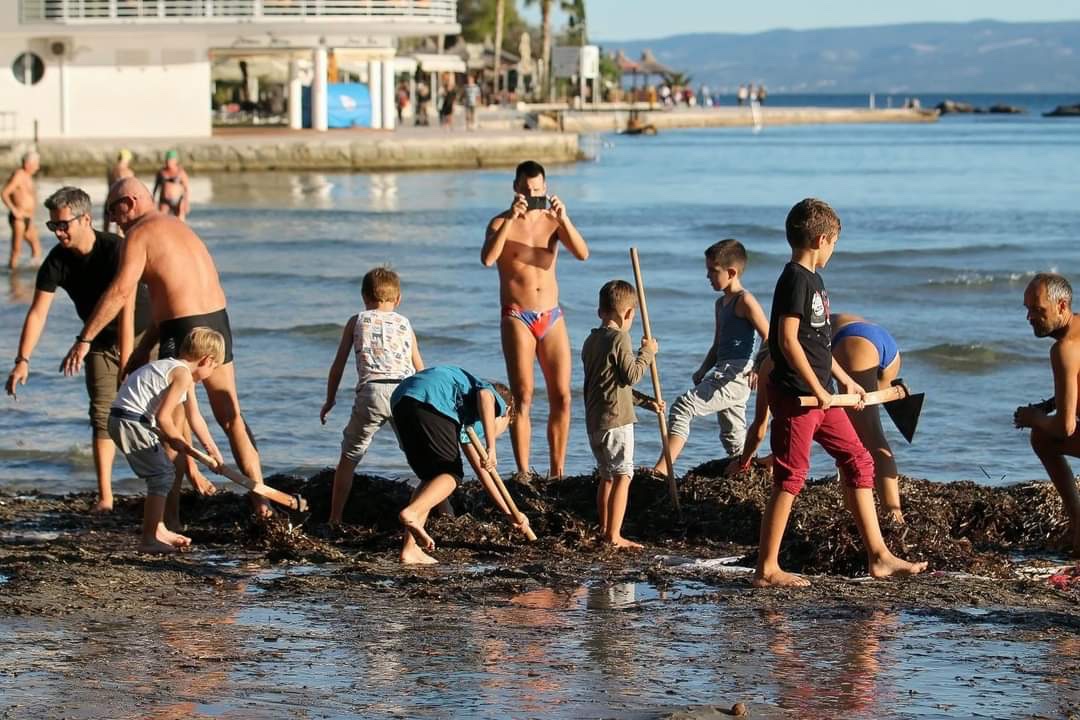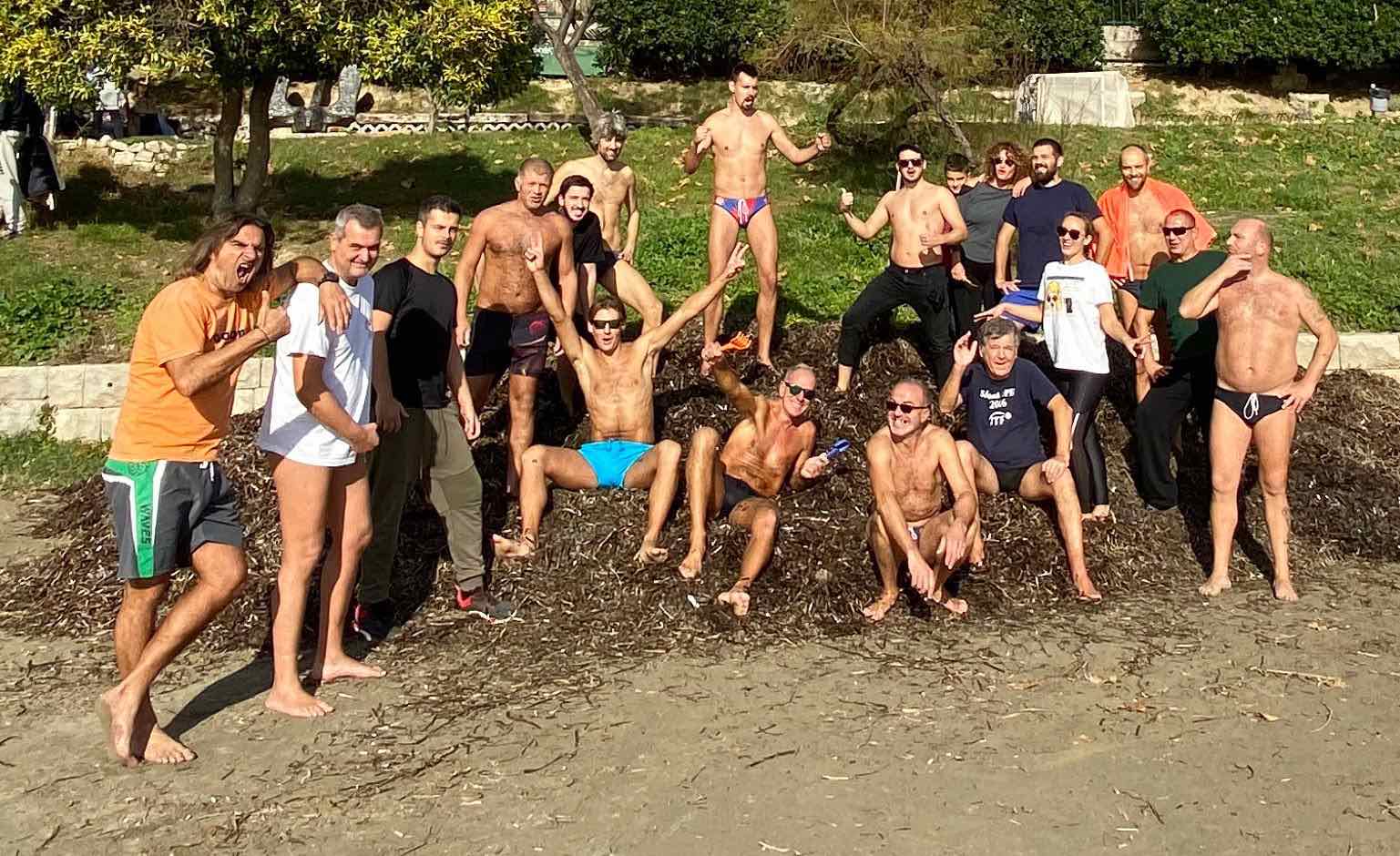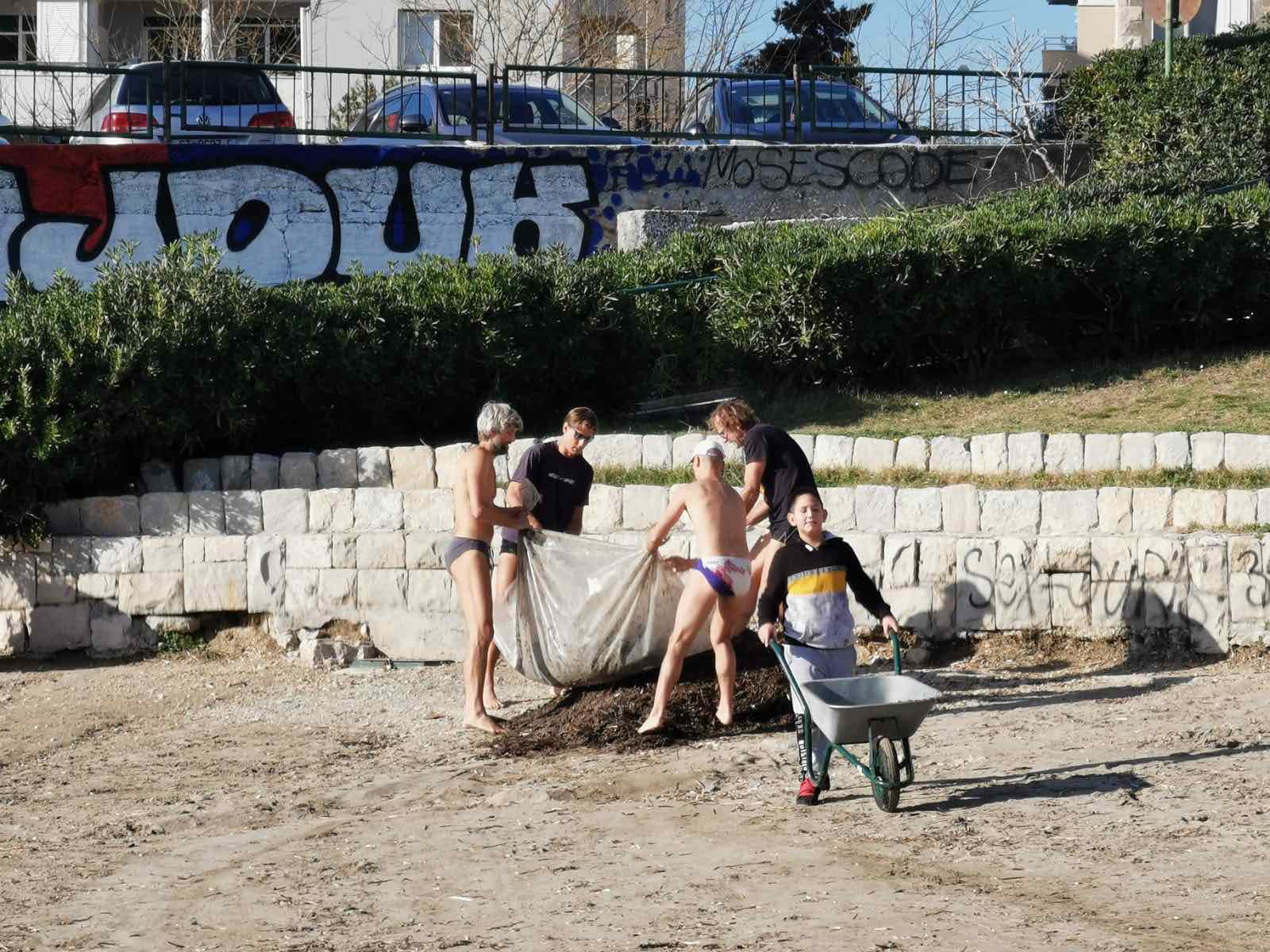Shaping a circular industrial ecosystem and supporting life-cycle thinking
Voga
{Empty}
Eco-friendly design and community participation project using seaweed that was collected from local shores.
Croatia
Local
Split
Mainly urban
It refers to a physical transformation of the built environment (hard investment)
Yes
2023-02-15
No
No
No
As an individual
A staggering amount of seaweed accumulates every year on Bačvice,
a famous tourist destination located in Split, Croatia. Local association,
Picigin Bačvice, carries out activities to regularly collect seaweed and
clean the beach to implement an outdoor sports activity program
including Picigin, a traditional ballgame played in the water a hundred
years ago in a shallow beach. Seaweed can be recycled entirely and it
emerged as an eco-friendly alternative to plastic by proving its potential
from both the aesthetic and functional perspectives. It also has the
characteristic of being able to be used as a cover for the roots of trees or
fertilizers because its abundant nutrition enriches the soil.
This project was started to provide benefits to both people and
the environment through the participation of local residents in activities
that enhance the utilization of resources and raising social awareness
while discovering the values of seaweed, a natural resource, that exists
abundantly in the region. First, the seaweed that is dried under the
sunlight was used to design a series of products and interior decor. A
local entrepreneur also used designer products made with seaweed
and provided financial support while resonating with the intent of the
project. The traditional method of manufacturing mattresses by inserting
dried seaweed as cushioning materials almost disappeared, but could
be revived through this project. Kamensko Association, established by
a group of employees from a closed clothing factory located in Zagreb,
donated fabric and materials that remained after sewing work so that
resource could be circulated through the project.
Afterwards, design products that used seaweed were sold
to nearby Voga café, and the proceeds were again donated to the
local association that collect seaweed. Voga café, run by members of
the association, is acting as a regional venue for exchange by hosting
exhibitions of local artists and so forth.
a famous tourist destination located in Split, Croatia. Local association,
Picigin Bačvice, carries out activities to regularly collect seaweed and
clean the beach to implement an outdoor sports activity program
including Picigin, a traditional ballgame played in the water a hundred
years ago in a shallow beach. Seaweed can be recycled entirely and it
emerged as an eco-friendly alternative to plastic by proving its potential
from both the aesthetic and functional perspectives. It also has the
characteristic of being able to be used as a cover for the roots of trees or
fertilizers because its abundant nutrition enriches the soil.
This project was started to provide benefits to both people and
the environment through the participation of local residents in activities
that enhance the utilization of resources and raising social awareness
while discovering the values of seaweed, a natural resource, that exists
abundantly in the region. First, the seaweed that is dried under the
sunlight was used to design a series of products and interior decor. A
local entrepreneur also used designer products made with seaweed
and provided financial support while resonating with the intent of the
project. The traditional method of manufacturing mattresses by inserting
dried seaweed as cushioning materials almost disappeared, but could
be revived through this project. Kamensko Association, established by
a group of employees from a closed clothing factory located in Zagreb,
donated fabric and materials that remained after sewing work so that
resource could be circulated through the project.
Afterwards, design products that used seaweed were sold
to nearby Voga café, and the proceeds were again donated to the
local association that collect seaweed. Voga café, run by members of
the association, is acting as a regional venue for exchange by hosting
exhibitions of local artists and so forth.
Sustainability
Community Engagement
Eco-friendly Design
Seaweed Utilization
Cultural Heritage
This project focuses on the sustainable and circular use of Posidonia oceanica, a marine plant native to the Mediterranean. Its primary objectives are:
1. Sustainability and Circularity: By utilizing fallen Posidonia oceanica leaves, the project creates a circular economy, transforming the material into organic, premium products, reducing waste, and cutting down on transportation costs. This aligns with sustainable production practices and promotes local resource utilization.
2. Environmental Conservation: Posidonia oceanica is vital for the Mediterranean ecosystem, aiding in oxygen production and coastal health. The project supports environmental conservation by responsibly harvesting this resource, benefiting both the ecosystem and the project itself.
3. Community Involvement and Local Production: The project encourages collaboration with local communities and entrepreneurs, fostering a sustainable economic cycle. It incorporates local craftsmanship, promoting knowledge-sharing and ensuring that the benefits stay within the community.
4. Product Innovation and Application: Posidonia oceanica’s unique properties, including thermal and sound insulation, mildew resistance, and fire resistance, make it ideal for creating innovative, eco-friendly products. The project encourages creativity in exploring its diverse uses.
5. Exemplary Model: The initiative can serve as a model for other regions, demonstrating how local, sustainable materials can be integrated into production while promoting community engagement and environmental preservation.
In conclusion, this project highlights the potential of using natural resources like Posidonia oceanica sustainably, supporting local economies, and reducing ecological impact through circular practices. It serves as an example of how creativity, nature, and sustainable practices can come together for the long-term benefit of both communities and the environment.
1. Sustainability and Circularity: By utilizing fallen Posidonia oceanica leaves, the project creates a circular economy, transforming the material into organic, premium products, reducing waste, and cutting down on transportation costs. This aligns with sustainable production practices and promotes local resource utilization.
2. Environmental Conservation: Posidonia oceanica is vital for the Mediterranean ecosystem, aiding in oxygen production and coastal health. The project supports environmental conservation by responsibly harvesting this resource, benefiting both the ecosystem and the project itself.
3. Community Involvement and Local Production: The project encourages collaboration with local communities and entrepreneurs, fostering a sustainable economic cycle. It incorporates local craftsmanship, promoting knowledge-sharing and ensuring that the benefits stay within the community.
4. Product Innovation and Application: Posidonia oceanica’s unique properties, including thermal and sound insulation, mildew resistance, and fire resistance, make it ideal for creating innovative, eco-friendly products. The project encourages creativity in exploring its diverse uses.
5. Exemplary Model: The initiative can serve as a model for other regions, demonstrating how local, sustainable materials can be integrated into production while promoting community engagement and environmental preservation.
In conclusion, this project highlights the potential of using natural resources like Posidonia oceanica sustainably, supporting local economies, and reducing ecological impact through circular practices. It serves as an example of how creativity, nature, and sustainable practices can come together for the long-term benefit of both communities and the environment.
This project showcases the intersection of design, environmental sustainability, and local culture to create meaningful experiences that benefit both people and the environment. Key highlights include:
1. Aesthetic Appeal: The project transforms often-overlooked seaweed into innovative design products, drawing attention to its natural beauty. The design reflects the local coastal culture, enhancing the connection between the community and the environment.
2. Quality of Experience: The project engages locals in activities like seaweed collection, promoting environmental stewardship and creating a sense of community. The sale of seaweed-based products at a local café strengthens the local economy and fosters cultural exchange.
3. Cultural Benefits: By integrating local heritage, the project preserves traditions while embracing sustainability. It instills cultural pride in the community, encouraging active participation and supporting local commerce.
4. Exemplary Aspects: The project exemplifies sustainability by repurposing seaweed, reduces waste, and supports a circular economy. It also raises awareness about the value of local resources and promotes social responsibility.
Conclusion: The project successfully combines design, sustainability, and cultural heritage to create positive social, cultural, and environmental impacts. It serves as a model for other regions to follow, demonstrating the potential of sustainable and culturally enriching initiatives.
1. Aesthetic Appeal: The project transforms often-overlooked seaweed into innovative design products, drawing attention to its natural beauty. The design reflects the local coastal culture, enhancing the connection between the community and the environment.
2. Quality of Experience: The project engages locals in activities like seaweed collection, promoting environmental stewardship and creating a sense of community. The sale of seaweed-based products at a local café strengthens the local economy and fosters cultural exchange.
3. Cultural Benefits: By integrating local heritage, the project preserves traditions while embracing sustainability. It instills cultural pride in the community, encouraging active participation and supporting local commerce.
4. Exemplary Aspects: The project exemplifies sustainability by repurposing seaweed, reduces waste, and supports a circular economy. It also raises awareness about the value of local resources and promotes social responsibility.
Conclusion: The project successfully combines design, sustainability, and cultural heritage to create positive social, cultural, and environmental impacts. It serves as a model for other regions to follow, demonstrating the potential of sustainable and culturally enriching initiatives.
The project aims to engage the local community by revitalizing traditional uses of seaweed, The initiative blends contemporary design with local traditions, focusing on sustainability, inclusivity, and environmental education. It promotes citizen participation, co-design, and collaboration with local entrepreneurs and organizations, such as the Ecological Society "Picigin Bačvice" and the Kamensko association.
Key objectives include:
1. Equal opportunities and public participation: The project encourages local citizens to contribute to seaweed collection, recycling, and the creation of eco-friendly products.
2. Citizen engagement and co-design: Community members, including women from the Kamensko association, participated in the production process, sharing their skills and knowledge.
3. Universal design and accessibility: The project integrates seaweed into accessible, eco-conscious products that are easy to use and beneficial to the whole community.
4. Environmental sustainability: Seaweed, as a renewable material, promotes eco-friendly practices, while also addressing local environmental concerns like beach cleanup.
5. Affordability: By using local, abundant materials and involving local entrepreneurs, the project keeps costs manageable and benefits the community economically.
This project can be seen as exemplary in its approach to sustainability, local engagement, and economic development, showcasing how a community can come together to create environmental and social value through innovation and tradition.
Key objectives include:
1. Equal opportunities and public participation: The project encourages local citizens to contribute to seaweed collection, recycling, and the creation of eco-friendly products.
2. Citizen engagement and co-design: Community members, including women from the Kamensko association, participated in the production process, sharing their skills and knowledge.
3. Universal design and accessibility: The project integrates seaweed into accessible, eco-conscious products that are easy to use and beneficial to the whole community.
4. Environmental sustainability: Seaweed, as a renewable material, promotes eco-friendly practices, while also addressing local environmental concerns like beach cleanup.
5. Affordability: By using local, abundant materials and involving local entrepreneurs, the project keeps costs manageable and benefits the community economically.
This project can be seen as exemplary in its approach to sustainability, local engagement, and economic development, showcasing how a community can come together to create environmental and social value through innovation and tradition.
The project successfully engaged local citizens and civil society in a variety of ways, leading to positive environmental, social, and economic outcomes. The Picigin Bačvice Association regularly collects seaweed, keeping the beach clean and turning seaweed into valuable products. The Kamensko Association contributed leftover materials, supporting the circular economy and empowering local women. A local entrepreneur integrated seaweed-based products into his business, financially supporting the project. The revival of traditional mattress-making with seaweed preserved cultural heritage, while Voga café acted as a venue for selling the products, generating funds for the project. Overall, these efforts not only addressed environmental issues but also created economic opportunities, fostered social inclusion, and promoted local traditions.
1. Picigin Bačvice Association: At the heart of the project, the association was crucial for the regular collection of seaweed and beach cleaning activities. They also promoted local traditions like Picigin, connecting environmental and cultural preservation. Their role in ensuring that seaweed was collected and utilized sustainably was vital. Added Value: The association created local community engagement, provided a direct link between the project and the beachgoers, and helped foster a sense of ownership and pride among residents.
2. Kamensko Association: The group of women from Kamensko, whose factory had closed, donated leftover materials for the project. Their involvement represented a local community’s response to economic hardship, contributing valuable resources. Added Value: This engagement added a social dimension, empowering women and offering them a sense of purpose and inclusion through their contributions to sustainability and circular economy practices.
3. Local Entrepreneur: By adopting seaweed as a material for designer products, the local entrepreneur not only contributed to the project’s success but also supported its financial sustainability. Added Value: The entrepreneur’s involvement brought a business perspective, helping to bridge the gap between environmental activism and economic viability.
4. Voga Café: Voga café supported the project by selling seaweed-based products and hosting exhibitions. Added Value: It provided a venue for community engagement and a market for the products, amplifying the visibility of the project and helping generate funds for further activities.
2. Kamensko Association: The group of women from Kamensko, whose factory had closed, donated leftover materials for the project. Their involvement represented a local community’s response to economic hardship, contributing valuable resources. Added Value: This engagement added a social dimension, empowering women and offering them a sense of purpose and inclusion through their contributions to sustainability and circular economy practices.
3. Local Entrepreneur: By adopting seaweed as a material for designer products, the local entrepreneur not only contributed to the project’s success but also supported its financial sustainability. Added Value: The entrepreneur’s involvement brought a business perspective, helping to bridge the gap between environmental activism and economic viability.
4. Voga Café: Voga café supported the project by selling seaweed-based products and hosting exhibitions. Added Value: It provided a venue for community engagement and a market for the products, amplifying the visibility of the project and helping generate funds for further activities.
The Voga project reflects a blend of environmental science, design, entrepreneurship, cultural heritage, and community engagement. Local seaweed, collected for beach clean-ups, is repurposed into eco-friendly products, highlighting sustainability. Designer creates functional, aesthetically appealing items, while local businesses, like Voga café, support the project by selling these products, with proceeds reinvested into environmental efforts. The project also revives traditional crafts, such as using seaweed in mattress manufacturing. Through collaboration, local residents, entrepreneurs, and artisans work together, enhancing environmental awareness, cultural preservation, and community involvement, resulting in a sustainable, socially responsible initiative.
The Voga initiative stands out for its innovative use of seaweed, positioning it as a sustainable alternative to traditional materials like plastic. Unlike mainstream practices that often rely on synthetic substances, Voga applies seaweed to create designer products, interior elements, and services without the need for chemicals. This approach not only enhances product quality but also offers a fresh experience for users. The project emphasizes environmental impact by promoting a clean and healthy ecosystem, benefiting local communities and fostering entrepreneurship. Its focus on researching seaweed's societal, environmental, and sustainability influences further distinguishes it from conventional methods in the field.
The methodology of the project is a blend of community-driven action, sustainable design, and resource circularity. Here's a breakdown of the approach:
1. Community Involvement & Awareness: The project began with engaging local residents, particularly through the Picigin Bačvice association, to participate in the regular collection of seaweed from Bačvice beach. This established a local workforce, fostering a sense of responsibility and awareness about the environmental issue at hand, while also encouraging people to see the seaweed as a valuable resource rather than a nuisance.
2. Resource Recovery & Upcycling: Once the seaweed was collected, it was dried naturally under the sun, which minimized energy use and maximized its eco-friendly potential. The seaweed was then repurposed for different uses, This process highlights the project’s emphasis on upcycling and finding value in what would otherwise be waste.
3. Collaboration with Local Businesses: The project fostered partnerships with local entrepreneurs and businesses, such as a local café and the Kamensko Association, which provided donated materials. By working with these entities, the project ensured the circulation of resources, both in terms of materials (like fabric) and profits, which were reinvested into the community through donations to the Picigin Bačvice association.
4. Design Innovation: A significant part of the methodology was the design process, where dried seaweed was incorporated into interior decor and products, giving it new life and purpose. This step emphasized the importance of innovation and creativity in making sustainable solutions both functional and aesthetically pleasing.
5. Social Impact: The connection between the local community and the beach was strengthened through product sales, helping people learn how to repurpose natural resources creatively while promoting sustainability and cultural preservation.
1. Community Involvement & Awareness: The project began with engaging local residents, particularly through the Picigin Bačvice association, to participate in the regular collection of seaweed from Bačvice beach. This established a local workforce, fostering a sense of responsibility and awareness about the environmental issue at hand, while also encouraging people to see the seaweed as a valuable resource rather than a nuisance.
2. Resource Recovery & Upcycling: Once the seaweed was collected, it was dried naturally under the sun, which minimized energy use and maximized its eco-friendly potential. The seaweed was then repurposed for different uses, This process highlights the project’s emphasis on upcycling and finding value in what would otherwise be waste.
3. Collaboration with Local Businesses: The project fostered partnerships with local entrepreneurs and businesses, such as a local café and the Kamensko Association, which provided donated materials. By working with these entities, the project ensured the circulation of resources, both in terms of materials (like fabric) and profits, which were reinvested into the community through donations to the Picigin Bačvice association.
4. Design Innovation: A significant part of the methodology was the design process, where dried seaweed was incorporated into interior decor and products, giving it new life and purpose. This step emphasized the importance of innovation and creativity in making sustainable solutions both functional and aesthetically pleasing.
5. Social Impact: The connection between the local community and the beach was strengthened through product sales, helping people learn how to repurpose natural resources creatively while promoting sustainability and cultural preservation.
The Voga project highlights the potential of using local natural resources like seaweed to create eco-friendly products while fostering community participation. Key elements of the project that can be replicated include:
1. Utilizing Local Resources: Seaweed and other local materials can be recycled into sustainable products in coastal or other resource-rich areas.
2. Community Participation: Involving local residents in collection and recycling activities to raise awareness and create a sense of community.
3. Collaboration with Entrepreneurs: Partnering with local businesses to support eco-friendly product creation and financial sustainability.
4. Reviving Traditional Techniques: Bringing back traditional crafts, like using seaweed in mattresses, and adapting them for modern use.
5. Regional Venues for Exchange: Establishing spaces like cafes or community centers for local artists and entrepreneurs to collaborate and showcase sustainable products.
6. Circular Economy: Creating a cycle where proceeds from eco-products are reinvested into local initiatives, supporting sustainable growth.
7. Education and Skills Development: Educating the community on sustainable practices and product development to encourage long-term environmental impact.
These elements can be adapted to various regions with different resources, cultural contexts, and community needs, fostering environmental sustainability and social cohesion.
1. Utilizing Local Resources: Seaweed and other local materials can be recycled into sustainable products in coastal or other resource-rich areas.
2. Community Participation: Involving local residents in collection and recycling activities to raise awareness and create a sense of community.
3. Collaboration with Entrepreneurs: Partnering with local businesses to support eco-friendly product creation and financial sustainability.
4. Reviving Traditional Techniques: Bringing back traditional crafts, like using seaweed in mattresses, and adapting them for modern use.
5. Regional Venues for Exchange: Establishing spaces like cafes or community centers for local artists and entrepreneurs to collaborate and showcase sustainable products.
6. Circular Economy: Creating a cycle where proceeds from eco-products are reinvested into local initiatives, supporting sustainable growth.
7. Education and Skills Development: Educating the community on sustainable practices and product development to encourage long-term environmental impact.
These elements can be adapted to various regions with different resources, cultural contexts, and community needs, fostering environmental sustainability and social cohesion.
The project addresses several global challenges by providing local solutions focused on sustainability, waste management, and community empowerment:
1. Waste Management & Pollution: It repurposes seaweed, often seen as waste, into valuable products, reducing marine litter and pollution.
2. Plastic Pollution: Seaweed serves as an eco-friendly alternative to plastic, promoting biodegradable materials and reducing plastic waste.
3. Climate Change & Ocean Health: By removing excess seaweed, the project helps protect marine ecosystems, and seaweed’s carbon absorption helps mitigate climate change.
4. Biodiversity Loss: The project promotes sustainable use of seaweed, preserving coastal ecosystems and supporting biodiversity.
5. Resource Depletion & Sustainable Agriculture: Seaweed is used as an organic fertilizer, offering a sustainable alternative to chemical fertilizers.
6. Social Inequality & Economic Development: It empowers the local community by creating economic opportunities through seaweed-based products and local entrepreneurship.
7. Cultural Preservation & Awareness: Revives traditional seaweed uses, preserving cultural heritage and raising awareness about sustainable practices.
8. Sustainable Tourism: Promotes eco-friendly tourism by integrating sustainable practices into local businesses and cultural activities.
In summary, the project addresses waste, pollution, environmental degradation, and social issues by using local resources, creating economic opportunities, and promoting sustainability. It serves as a model for other communities facing similar global challenges.
1. Waste Management & Pollution: It repurposes seaweed, often seen as waste, into valuable products, reducing marine litter and pollution.
2. Plastic Pollution: Seaweed serves as an eco-friendly alternative to plastic, promoting biodegradable materials and reducing plastic waste.
3. Climate Change & Ocean Health: By removing excess seaweed, the project helps protect marine ecosystems, and seaweed’s carbon absorption helps mitigate climate change.
4. Biodiversity Loss: The project promotes sustainable use of seaweed, preserving coastal ecosystems and supporting biodiversity.
5. Resource Depletion & Sustainable Agriculture: Seaweed is used as an organic fertilizer, offering a sustainable alternative to chemical fertilizers.
6. Social Inequality & Economic Development: It empowers the local community by creating economic opportunities through seaweed-based products and local entrepreneurship.
7. Cultural Preservation & Awareness: Revives traditional seaweed uses, preserving cultural heritage and raising awareness about sustainable practices.
8. Sustainable Tourism: Promotes eco-friendly tourism by integrating sustainable practices into local businesses and cultural activities.
In summary, the project addresses waste, pollution, environmental degradation, and social issues by using local resources, creating economic opportunities, and promoting sustainability. It serves as a model for other communities facing similar global challenges.
This project focuses on using natural, renewable seaweed as an eco-friendly material, promoting environmental protection, and fostering local community involvement. By revitalizing traditional Mediterranean practices, it offers a greener alternative to plastic, as seaweed is fully recyclable and can return to nature as organic fertilizer. The local association Picigin Bačvice collects seaweed from Bačvice beach, where it is dried and transformed into products like interior décor, root covers, and fertilizer, all while cleaning the beach. Local residents and entrepreneurs are engaged in this initiative, upcycling materials like fabric from a closed clothing factory. Products are sold at a nearby café, Voga, with proceeds supporting ongoing seaweed collection efforts. The project encourages sustainability, local economic development, and social inclusion, while also reviving historical practices such as using seaweed in mattress production.

